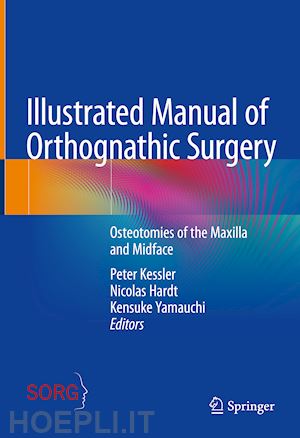
Questo prodotto usufruisce delle SPEDIZIONI GRATIS
selezionando l'opzione Corriere Veloce in fase di ordine.
Pagabile anche con Carta della cultura giovani e del merito, 18App Bonus Cultura e Carta del Docente
The second of a multi-volume set takes into account the deficit of experience and knowledge gained from 3D preoperative planning and postoperative control using new radiological protocols in surgical procedures, with corresponding consequences. It contrasts the established standard techniques of orthognathic oral and maxillofacial surgery with alternatives that are based on years of experience and knowledge gained from better radiological analysis. Orthopaedic oral and maxillofacial surgery has experienced a renaissance in recent years, primarily due to three-dimensional radiological imaging.
The book has deliberately been structured in such a way that the clinical situation is contrasted with a graphic representation for better understanding, which is intended to point out special situations that can in turn positively influence the surgical planning of the intervention in order to avoid undesirable results in the individual case. The book will have a reduced text part, but witha lot of illustrations, in order to show the surgeon, who works image-oriented, the logic of the surgical procedure in a simple and clear way. The graphic illustrations will illustrate the three-dimensionality of the complex anatomy in the midface region close to the orbits and the skull base. Illustrations must help where radiological images fall short. The structure of the book will nevertheless be classic, as the variations of the established techniques can only be understood on the basis of historical development.I. Introduction to Orthognathic Surgery in the Maxilla/Midface.- Chapter 1. Classification and Facial Patterns in Dysgnathias of the Maxilla and Midface.- Chapter 2. Types of Osteotomies in the Maxilla.- Chapter 3. Definition of Standard Indications and Surgical Procedures.- II. Osteotomies in the Maxilla and Midface.- Chapter 4. Segmental Osteotomies in the maxilla.- Chapter 5. Development of Le Fort I Osteotomies.- Chapter 6. Le Fort II osteotomy.- Chapter 7. Le Fort III and frontal monobloc osteotomies.- Chapter 8. Immediate and Late Complications after Midface Osteotomies.- III. Osteotomies in the Maxilla/Midface – General Planning.- Chapter 9. Pre- and Perioperative Care in Orthognathic Surgery - Anesthesiology and CMF-Surgery.- Chapter 10. Patient and Data Acquisition.- Chapter 11. General Planning and Preoperative Assessment.- Chapter 12. Preparations for the Surgical Procedure.- Chapter 13. Postoperative Care in Orthognathic Surgery.- IV. Le Fort Osteotomies in the Maxilla/Midface.- Chapter 14. Clinical Anatomy and the Le Fort – Osteotomies.- Chapter 15. Anatomical Reference Points – Indispensable Aids.- Chapter 16. General Rules in Le Fort Osteotomies – six steps.- Chapter 17. Intraoperative Hazards and Risks.- Chapter 18. Complication Prevention and Care after Midface Osteotomies.- V. Distraction Osteogenesis in the Midface and Maxilla.- Chapter 19. Distraction Osteogenesis in the Midface and Maxilla.- VI. Anterior Maxillary Osteotomy – AMO – Anatomical, Technical and Surgical Aspects.- Chapter 20. Anatomical Aspects.- Chapter 21. AMO – Technical Aspects.- Chapter 22. AMO – Method, Principles and Limitations.- Chapter 23. AMO – Wassmund Technique.- Chapter 24. Wunderer Technique – 1963.- Chapter 25. Anterior Maxillary Down-fracture Techniques – Cupar 1954, Bell 1971, 1977 and Epker 1977.- Chapter 26. Anterior Maxillary Osteotomy – Management after Surgery – Postoperative Care.- Chapter 27. Intraoperative Hazards and Risks – Danger Points – Complicationsof AMO.- Chapter 28. Variants of AMO.- VII. Posterior Maxillary Osteotomy – PMO – Anatomical, Technical and Surgical Aspects.- Chapter 29. Posterior Maxillary Segment Osteotomy – PMSO – Introduction.- Chapter 30. Posterior Maxillary Segment Osteotomy – PMSO – Indications.- Chapter 31. Posterior Maxillary Segment Osteotomy – PMSO – Step-by-step Procedure.- Chapter 32. Posterior Maxillary Segment Osteotomy – PMSO – Reference and Danger Points.- Chapter 33. Posterior Maxillary Segment Osteotomy – PMSO – Rules and Tricks.- Chapter 34. Posterior Maxillary Segment Osteotomy – PMSO – Complications.











Il sito utilizza cookie ed altri strumenti di tracciamento che raccolgono informazioni dal dispositivo dell’utente. Oltre ai cookie tecnici ed analitici aggregati, strettamente necessari per il funzionamento di questo sito web, previo consenso dell’utente possono essere installati cookie di profilazione e marketing e cookie dei social media. Cliccando su “Accetto tutti i cookie” saranno attivate tutte le categorie di cookie. Per accettare solo deterninate categorie di cookie, cliccare invece su “Impostazioni cookie”. Chiudendo il banner o continuando a navigare saranno installati solo cookie tecnici. Per maggiori dettagli, consultare la Cookie Policy.